About this Blog: Aryan Valley or the land of Brokpas always had an air of mystery around it. Recently we had visited Garkon, one of the villages in Aryan Valley located in the Batalik sector of Ladakh. In this travel blog, we have tried to briefly explain the culture, history and lifestyple of the Brokpa community, also known as the Dard Aryans. Along with that, this blog will also serve as your complete Aryan Valley Travel guide where we have listed how to reach, what to see and where to stay at the Valley.
We had first heard about Aryan Valley when we were in Leh back in 2013. We learnt that it was a place where the last remaining Aryans lived. And along with those various interesting and intriguing stories. The picture showed us men and women with colourful headgears. All these pictures and stories definitely warranted a visit to the Aryan village inhabited by the Brokpa community. We did not visit the place then, but got an opportunity to visit Garkon, a village in Aryan Valley the previous year, on our way back from Zanskar.
When I first did a google search of Aryan Valley, it gave me a myriad of results. The stories about the place and its people surprised me. Some said that the inhabitants were the descendants of Alexander, the great! While there are stories about how they are ethnically a superior race. Some also claimed that the people are really tall – more than 6 feet (something that is rarely seen in Ladakh). Aryan Valley definitely seemed an enigma.

What is so special about the Aryan Valley and the Brokpa community? Why is there so much mystery surrounding this place? Read on to know more.
Ladakhi population mainly consists of Buddhists and Muslims with a few Hindus scattered here and there. However, there is a settlement spread across five villages in the Batalik sector that have attracted a number of anthropologists. These five villages – Dah, Haanu, Beema, Darchik and Garkon are the home to the Dard Brokpa community, also known as the last Aryans of Ladakh.
Cultural History of the Brokpa People
This is definitely one of the most interesting parts of the Brokpa tribe. There are quite a number of theories suggesting the origin of the Brokpas. One section of historians’ state that the Brokpas or Aryans are perhaps the direct descendants of the soldiers of Alexander the Great’s army. Tired and battered after endless wars, a few of them might have stayed back in the region almost 2000 years back while their leader, Alexander returned back to Greece. Although this seems to be the most popular theory regarding the Ladakhi tribe, this also seems a bit far-fetched.

Another theory exoticizes them as the “last pure specimens” of the Aryan race because of their more than average Indian height, sharp features and blue eyes. They are said to belong to a genetically superior race. While I personally do not believe in the superiority of any particular race or creed, this fact is definitely a harmless means to boost tourism in the area. Infact, I had also heard about a new term “pregnancy tourism” related to these villages. I will come to that in a later section.
Brokpas – People from Dardistan
The most plausible theory regarding the Brokpas, is perhaps, that they are of Dardic origin coming from northern Pakistan’s Gilgit Baltistan and Khyber Pakhtunkhwa, Jammu and Kashmir, and eastern Afghanistan. Infact, the word “Dard” comes from a Sanskrit word “Daradas” meaning people living on the hillside. The Dards speak a distinct dialect of Dard-Shina, which is also known among the people of Ladakh as Brokskat. They have no script.
Whichever theory you decide to believe in, it is but clear that the Brokpas are ethnically, physically, culturally and religiously different from the people of the rest of Ladakh. Tibeto-Mongolian features are not seen in them as in the majority of Ladakhis. Neither can you see any Balti traits as found in the villages of Turtuk. Instead, they exhibit Indo-Aryan features with long hair, pale skin, high cheekbones and light-coloured eyes. Both men and women are significantly taller than the Tibetan benchmarks.

Brokpa Attires and Headgears
The Brokpas are known for their distinctive attire and colourful headgears. However, it is very difficult to see them in their complete traditional attire on a normal day. They dress up in their full attire only during festivals and ceremonies. In the Leh market area, you can see a few of them wearing the headgears selling dry fruits. Perhaps they wear it in the market so as to stand out and attract tourists to their shops. You might also get to see a few old ladies wearing the headdress in the villages.

The colourful and elaborate headgear that identifies a Brokpa is known as Tepi. Tepi has various colourful props attached to it and is embellished with berry flowers. Coins and needles are a part of the decoration of the Tepi. The locals believe that the Tepi wards off the evil eye.
As I heard from our host, a local of Garkon village, each prop on the tepi has some significance. The seven coloured ribbons are there to ward off any ailment caused by the sun and eclipse. The silver brooches ward off planetary influences and the peacock feathers help to ward off paralysis.
As for the dress, both the men and women wear sheep wool pherans. The men mainly wear a maroon-coloured gowns with a cummerbund. They also wear a sheepskin cape. The women wear jewellery made of gold, silver or heavy metal. Old metal coins are also an integral part of the accessories.

Aryans and their religion and Lifestyle
As I mentioned earlier, the Aryans or Brokpas are religiously different as well. They had so long resisted external influences on their culture and religion. Neither do they completely follow Tibetan Buddhism of Ladakh, nor have they embraced Islam like the people living on their west. The Brokpas are mainly followers of Bon religion, something that we had encountered at Tawang. They are mainly nature worshippers and have utmost regards to the resources around them. Though some Buddhist influences have been found, they have proudly preserved their heritage and culture. They still follow their old custom of worshipping rivers, trees, mountains and stones and practice a form of animism.

Livelihood
The Brokpas mainly practise animal husbandry rearing sheep and goat for their milk and meat. Interestingly, they do not consume poultry and dairy-sourced products. Mutton and sheep form a part of their diet, especially during celebrations.
Life at Aryan Valley also depends heavily on local produce. The region is also known for its apricot plantations. The place becomes absolutely gorgeous during the apricot blooming season. Apart from apricots, mulberry, blackberry, gooseberry and grapes are also found in abundance.

The Brokpa valley or the Aryan valley was a closed off area for a long time. Outside influences were almost non-existent. The Brokpas have a long-standing practice of endogamy. Marriages outside the community are frowned upon. These practices led to maintaining their unique cultural identity.
Both polyandry and polygamy are common in the community. Women have equal representation and have the right to divorce.
Of late, interreligious marriages with the Shia Muslim community have also resulted in conversion of some of the Aryans. But their age-old faith and ritualistic practices still remain strong.

Aryan Valley Festival
One of the major festivals of the Brokpas is the Bono-na festival. This festival takes place in Garkon every 3 years. Bono-na is a festival of the Dards. The festival takes place in rotation in 3 places. One year, it takes place at Dah and Biama, then at Garkon and Darchik and for the third year, it takes place at a village in Baltistan (which is now in Pakistan).
While the Brokpas have tried hard to preserve their cultural identity, it is becoming hard these days. The Dard men are migrating to other parts of the region in search of employment and are also marrying outside the community. Migration and modernisation pose a threat to their cultural identity as is found in most of the remote places. This is something that we encountered in Zanskar as well. Modernity, technology while being a boon to the local people, is also a gradual threat to their traditions and culture.
Geography of Aryan Valley

The Aryan Valley or the Brokpa region is located in the Batalik sector of Ladakh. The five main villages of the region are Dah, Hanu, Biama, Garkon and Darchik. Other smaller villages are also scattered across.
If you start from Leh and take the Leh-Srinagar Highway towards Kargil, you will find a small road bifurcating from Khaltse that goes towards Dah- Beema area. This road goes beside the Indus River, passes through Batalik and finally rejoins a highway near Kargil.
The first few villages that you encounter on the road are Ladakhi villages. Only when you cross Hanu, you enter the Brokpa region. Most of these villages are located on the banks of River Indus and are lower than the altitude of Leh. Quite naturally, these areas are more fertile and you will encounter more greenery here. You will see farms of buckwheat, barley, millets and orchards of walnut, apricot, apples and grapes here.
Local geopolitical situation has divided the region into two parts. While Dah, Hanu and Biama fall in Leh district, Garkon and Darchik fall in Kargil district.

Our Trip through Aryan Valley
To be honest, we had not planned on visiting the Aryan Valley or Brokpa region during this trip. We had just completed our Zanskar Road trip and had stopped at Kargil for the night. We were just reminiscing about our time in Zanskar valley when I suddenly suggested a stop at Aryan Valley. With this in mind, we asked Tashi, our companion on the entire trip about Aryan Valley. He simply agreed with a smile and “chalenge” (we will go)!

The next morning, we started from Kargil and took the road towards Batalik. We crossed Darchik and continued further towards the next village. Soon we reached Garkon village. Tashi knew someone from Garkon village and we decided to stay at Garkon.
We entered the village with our backpacks looking for Payupa Guest House. This was the guest house we found on facebook with our limited access to the internet. The first person we met in the village was an old lady wearing a typical traditional headdress while she was drying apricots.

The lady gave us a toothy smile and offered us apricots. But as soon as she saw the camera, she nodded her head. She gestured that she would allow us to take photographs only if we gave her money. Well, what can we say? We offered her money and she let us take her pictures. However, later she gave us a handful of apricots each, all for free! Photography, however, is not free!
At Payupa Guest House
We reached Payupa Guest House, which is one of the oldest guest houses in the area. We got a room on the first floor overlooking the apricot gardens. The guest house was looked after by Nawang and his sister in law. Payupa guest House was quaint and cosy and Nawang shared quite a number of stories about the Brokpa culture and their history with us.

To be honest, I was actually looking for blue eyes and exceptionally tall people in Garkone. Infact, I was keenly looking at Nawang’s eyes to find specks of blue or light colour so much that at one point I felt that I was stalking him! Alas, his eyes were brown, maybe a shade lighter than my own brown eyes! But yes, the men and women were taller than the average height of the rest of the Ladakhi counterparts.
Apparently, most of the family members work in different parts of Ladakh and do not stay in the village. I found this for many of the families at Garkone. We had met 2 little girls at the village who became our companion whenever we went out to explore the village. They too stayed and went to school in Leh. They were now at Garkon as their school was closed.

We reached by noon and after having our lunch, we went to explore the village. Garkon is a small village with fertile patches of land, buckwheat fields and apricot orchards. There is a small monastery inside the village. While many of the villagers have embraced Tibetan Buddhism, they have also kept their age old rituals and practices close to their heart.
Heritage House at Garkon
In the evening, we went to explore the heritage house. It is a part of the Payupa Guest House, where they have preserved their old architecture and structure and converted it into a museum. Nawang took us through their history and shared stories about his ancestors. He also shared anecdotes from his childhood. Photography and videography is not allowed inside the heritage house.
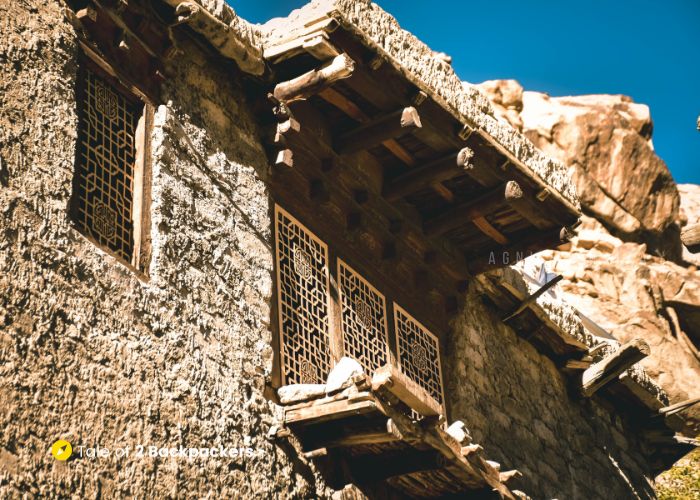
Nawang shared an interesting tale about the origin of the Aryans. It was the story of 5 Aryan brothers who had migrated from Gilgit-Baltistan. Two of them went towards Kashmir and 3 settled down at the place, which is currently known as the Aryan valley. The elder brother settled at Hanu, while the younger two at Dah and Garkon. The local king of Ladakh wanted the brothers to submit to them. But the 3 brothers refused to be under any authority. They declared that the Brokpas would not submit to anyone. Since then, these Brokpa villages have lived in isolation preserving their own culture and traditions.

Perhaps, the notion of the Aryan being a superior race has stemmed from this story. I can only speculate.
At night, we enjoyed local home-made wine around a campfire with local music and dance, which turned out to be an awesome experience.
Exploring Garkon

The next morning, we woke up and went out to explore the village again. There is a hanging bridge over the Indus River. On the other side of the bridge there is an uphill trail that leads to Garkon Fort and monastery. We did not have much time in hand and so skipped visiting the fort and kepton walking on the Indus valley road that would apparently lead to Dah. We walked for about half an hour by the Indus River and then decided to return back.

After a late breakfast, we started for Leh. On our way, we stopped at Domkhar Rock Art Sanctuary. This is perhaps one of the oldest man-made works of art that we had seen. I will be writing an article on it separately.

While driving towards Leh, we crossed a few other villages. We crossed Biama and Hanuthang (we did not enter the villages, just drove along the way). Dah is perhaps the most important village in the Aryan Valley. Most of the tourists coming from Leh usually visit Dah and Hanu. Perhaps, we will visit Dah the next time we are in Ladakh. This time, it was only Garkone where we got a glimpse of the Brokpa life and culture. And believe me, I would love to get a more detailed perspective of their culture again.

Aryan Valley and Pregnancy Tourism
When I was searching about Aryan Valley on the internet, I came across this term “Pregnancy Tourism”. Quite obvious, it piqued my interest. As I mentioned earlier, the Aryans have been long extolled and exocitized for their facial features, eye colour and blonde hair. And with that the connotation of being the superior Aryan race. Another moniker that the Aryan or Brokpas had attained is that they belong to the “Pure Race” having “Pure Aryan Blood” (whatever that means)!
To cut a long story short, it is said that European women come to the Aryan villages with the hope of getting impregnated by men who are believed to be racially pure Aryans. The women come to these villages, fornicate with local men and then return back to their countries with a child of “pure race”.
To be honest, this story or fact (I do not know which) is cringeworthy, but this rumour of Pregnancy Tourism has introduced the Aryan Valley to the rest of the world. While I personally have not asked any of the people I met there about this fact, this rumour of Pregnancy tourism has been denied by the local people at large.
Places to visit in Aryan Valley
This part is for those readers who want to know about the attractions in the Aryan Valley. We have not visited all of them, but gained knowledge about them from the locals.
Darchik

If you are coming from Kargil side (like us), darchik is the first Aryan village that you will encounter. Darchik is located on the other side of the river and has a couple of homestays.
Garkone
It is the Brokpa village where we stayed. Exploring the village, talking to the local people is something that you will enjoy. Other than that, there is a lovely hanging bridge and a village monastery. If you are up for hiking, then you can cross the hanging bridge and visit the other monastery and the Garkon Fort.

Dah
As I mentioned, Dah is perhaps the most important village in the Aryan Valley or Brokpa Valley. While being a beautiful village, there are a few attractions that you should not miss.
Duhya (Village deity)
This is the place of worship of the local village deity Srigmo. The locals pray to the deity for the fulfilment of their needs and aspirations. A local family of Dah meditates at this place for seven days before the commencement of the Bono-na festival of the Dards.
Aryan Valley Museum
Just like the heritage Museum at Garkon, Dah also has a museum that attempts to preserve the Dard and Brokpa heritage. The museum has traditional pottery, old dresses, ritual objects and holy stones.
Dard Fort
There is a 3-storied fortified structure in the village which is almost in ruins now.
Biama
Biama is located on the main road. It has a beautiful monastery on a hilltop. It would take a bit of hiking to reach the place.
Hanu
At Hanuthang, a small road bifurcates to reach Hanu, another important Aryan village.
Achinathang
Achinathang is another beautiful village. This place is known for its ancient petroglyphs and monastery. The village also has some beautiful pastures.
How to Reach the Aryan valley?

You can reach the Aryan Valley or the Brokpa Valley either from Leh or Kargil. If you are visiting from Leh, you will probably visit the villages of Dah and Hanu. You can also do a day trip from Leh to Aryan Valley.But we would recommend staying at least one night to truly experience the place.
You can book cars from Leh city for a trip to Aryan Valley. The taxi rates for Ladakh are fixed by the taxi union, so there is less scope of bargaining.
If you wish to explore the place by public transport, then buses are available from both Leh and Kargil. Morning buses are available from Leh bus stand to Dah that passes through Nummu, Khaltse, Domkhar, Skurbuchan, Achinathang, Hanuthang and Bima. These buses are available 6 days a week.
However, after the pandemic, bus timings have become a bit awry. We asked about the local bus timings from a shopkeeper at Garkon. Apparently, his shop is the bus stop at Garkon. He informed us that buses from Darchik to Leh are available on alternate days. But the timings are not quite fixed. The day we visited, the bus from Darchik to Leh was cancelled. So, if you are planning to travel by local buses, get information about the bus timings beforehand. And keep extra days in hand.
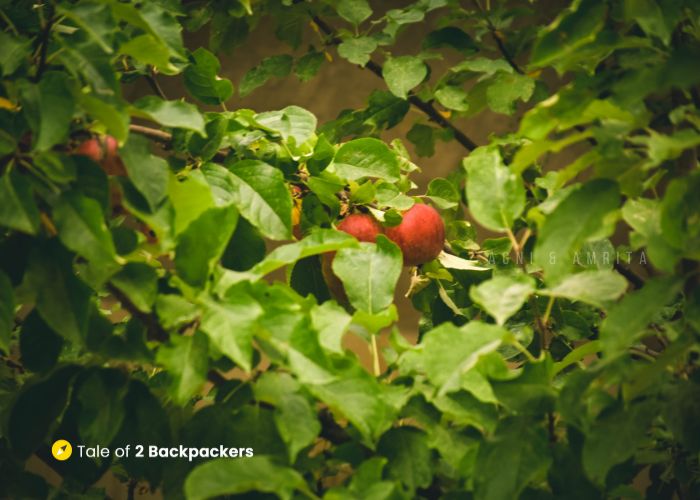
What to do at Aryans Valley?
- Experience the Brokpa culture and people. Talk to them, listen to their stories. If you want to take photographs, please ask for permission.
- Enjoy the natural views of the Indus Valley, the greenery and the fruit orchards. The apricot blooming season in April will quite mesmerise you. I do plan to visit the place someday during that season.
- You will find ancient petroglyphs and rock art in the region.
- Try the local food and local wine.
- If possible, visit during a festival season to see the Brokpas in their full traditional attire.

Is Permit needed to visit Aryan Valley?
You will need permits to visit Aryan Valley and you can obtain them online these days. However, after the formation of Ladakh Union territory, things are a bit confusing. If you are visiting from Leh, you will require a permit. However, we did not require any permit while visiting Garkon from Kargil.
Homestays in Aryan Valley

Aryan Valley is a small area and relatively offbeat. As such it does not have a lot of staying options, but there are a number of homestays in almost all the major villages.
At Garkon, we stayed at Payupa Guest House. There is also a government guest house at Garkon village, though we did not see any caretaker when we visited.
Darchik, Dah and Biama also have a couple of homestays.
Achinathang also has a nice homestay – Achinathang Traveller’s Home, of which I have heard good reviews.
Points to remember while visiting Aryan Valley
- The nearest town to Aryan Valley is Khaltse from Leh side and Batalik from Kargil side. You can approach the valley from either Leh or Kargil.
- Dah, Hanu and Biama fall in Leh district while Garkon and Darchik fall in Kargil district.
- You can take a day trip to the Aryan Valley.
- Explore the place and experience its culture. And while doing so, respect their choices, even if you do not agree with them. The Brokpas are respectful of their nature and surroundings. Be respectful to the people and their culture. While taking photographs, ask for permission.
- To reach the villages, you might have to hike a bit.
- If you plan to hike, then it is better to do so earlier in the morning. The days are sunny and hot. Nights are definitely colder and you will need jackets and woollens for the night.
- Network is pure in the region. In Ladakh, only postpaid network works. We had Airtel postpaid and the network was quite poor. Internet connectivity was non-existent inspite of Airtel’s claim of reaching places. Jio network was also poor.

The Aryan Valley of the Brokpa Valley is an interesting place. In spite of all the rumours surrounding the village, the people are warm and friendly. How far the myth of Aryan bloodline or Aryan race is true is yet to be determined. I always believe that the concept of superiority is relative. The Aryans as I saw them are extremely conscious about nature, like most of the communities staying in remote hilly areas. They are in constant endevour to preserve their culture and are quite liberated. I can only ask you to look beyond the ideas of master race and pure blood and see the Brokpas for what they are.

So, what do you think of Aryan Valley and the Brokpa community?Have you visited the place? Please share your thoughts on the same in comments below. We would love to hear from you.
If you liked this post and foyund it useful, please share this with your family, friends and neighbours.
Pin it for a later read!



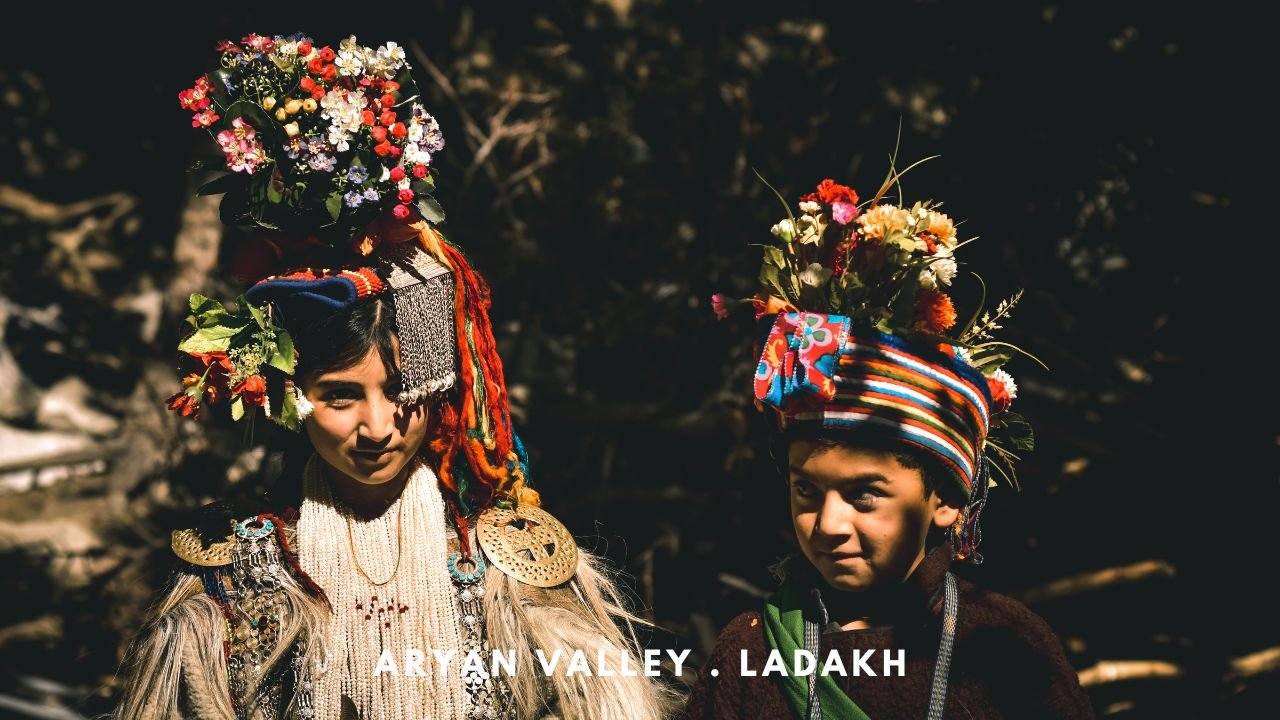

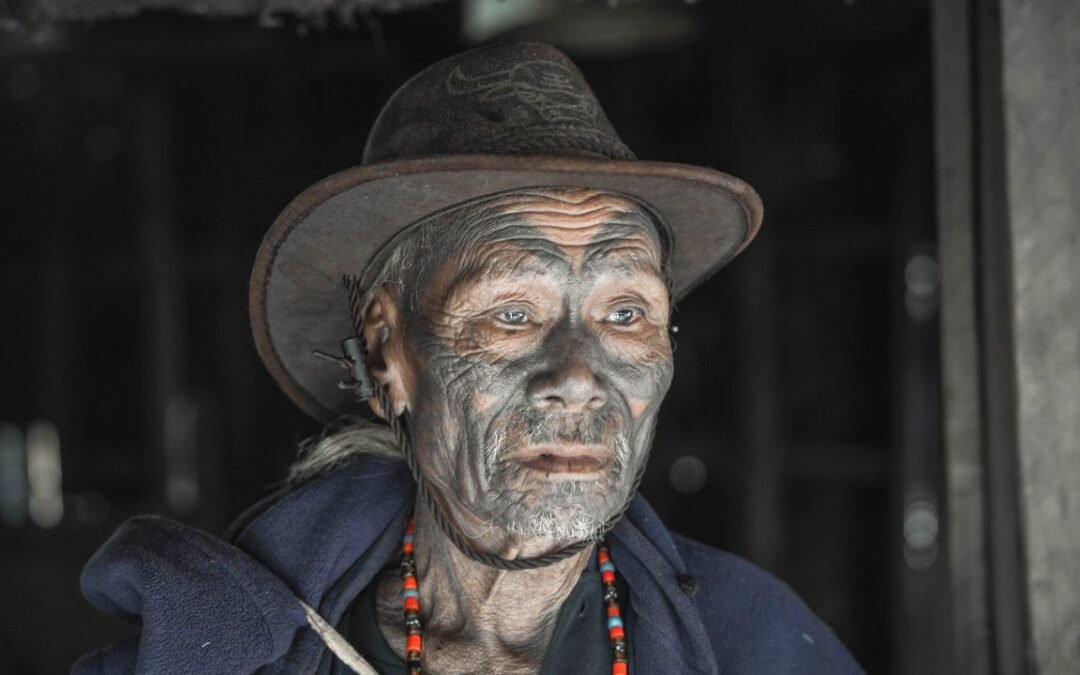
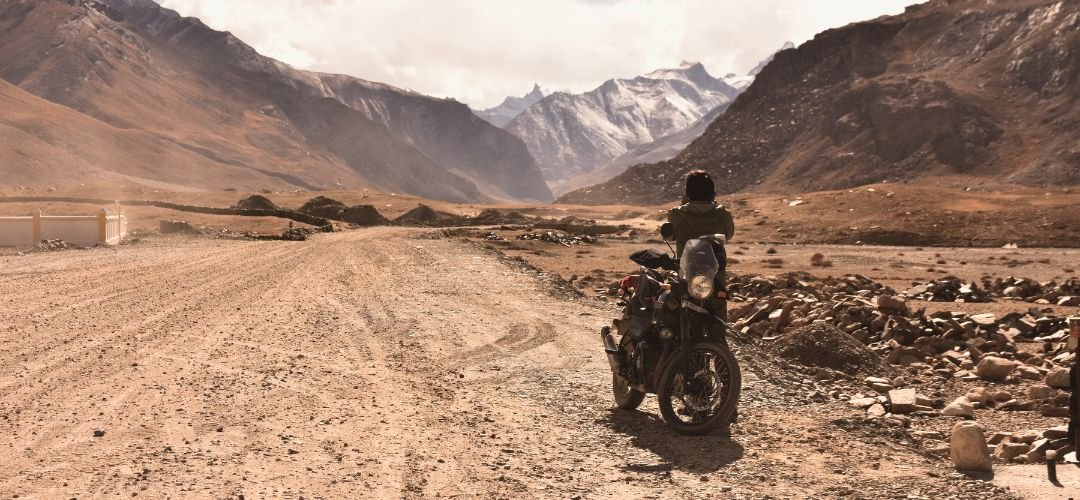
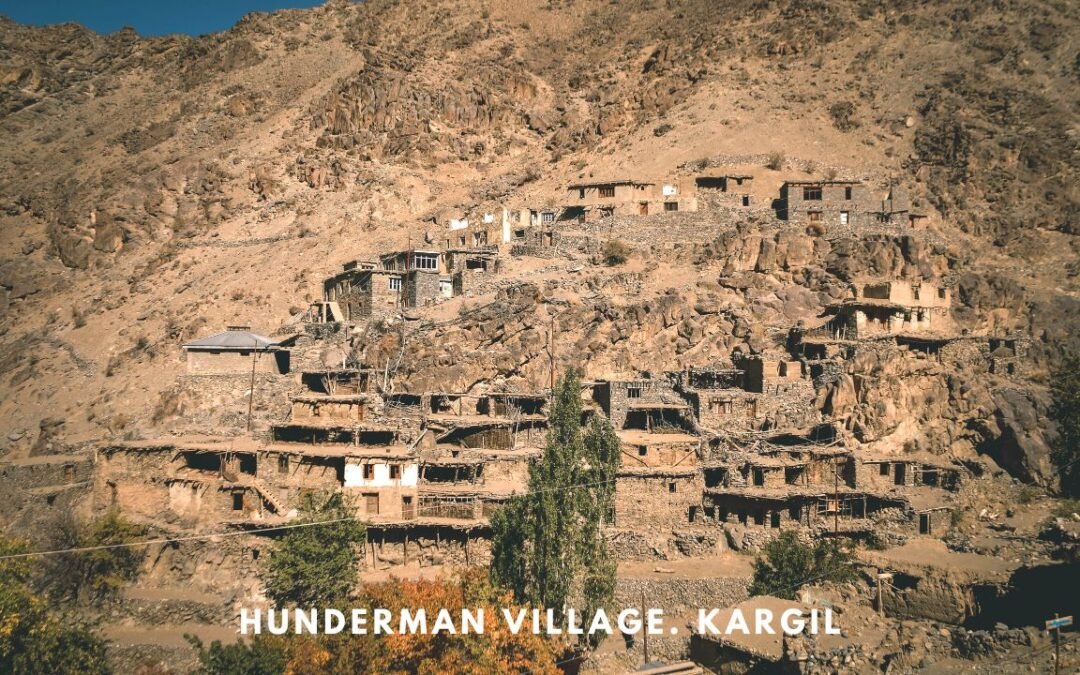
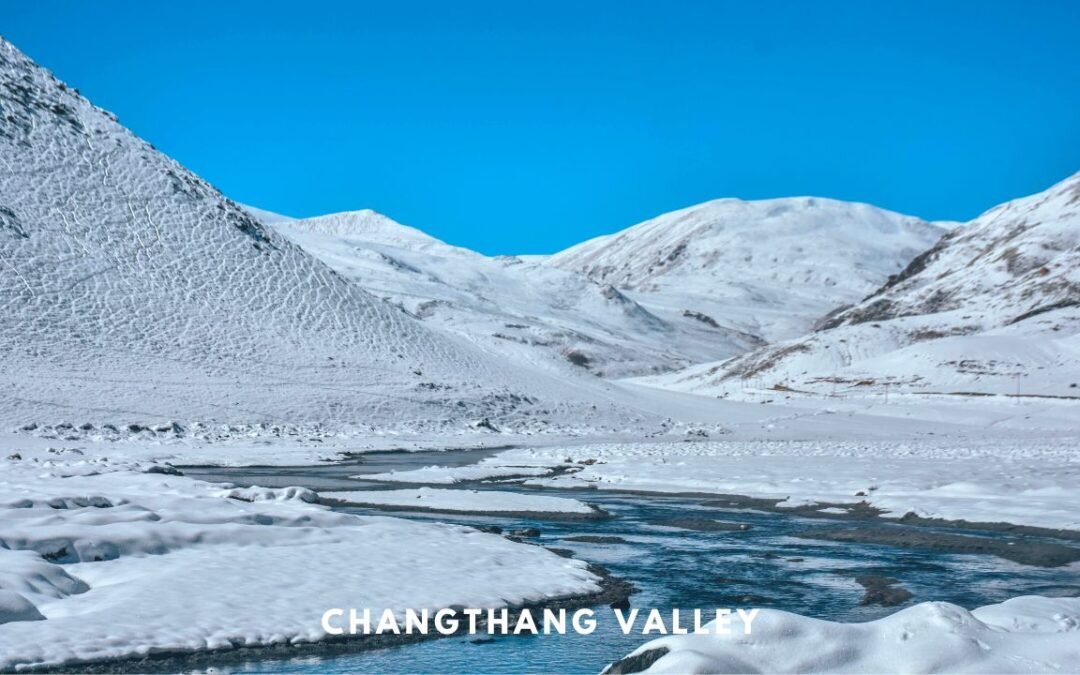
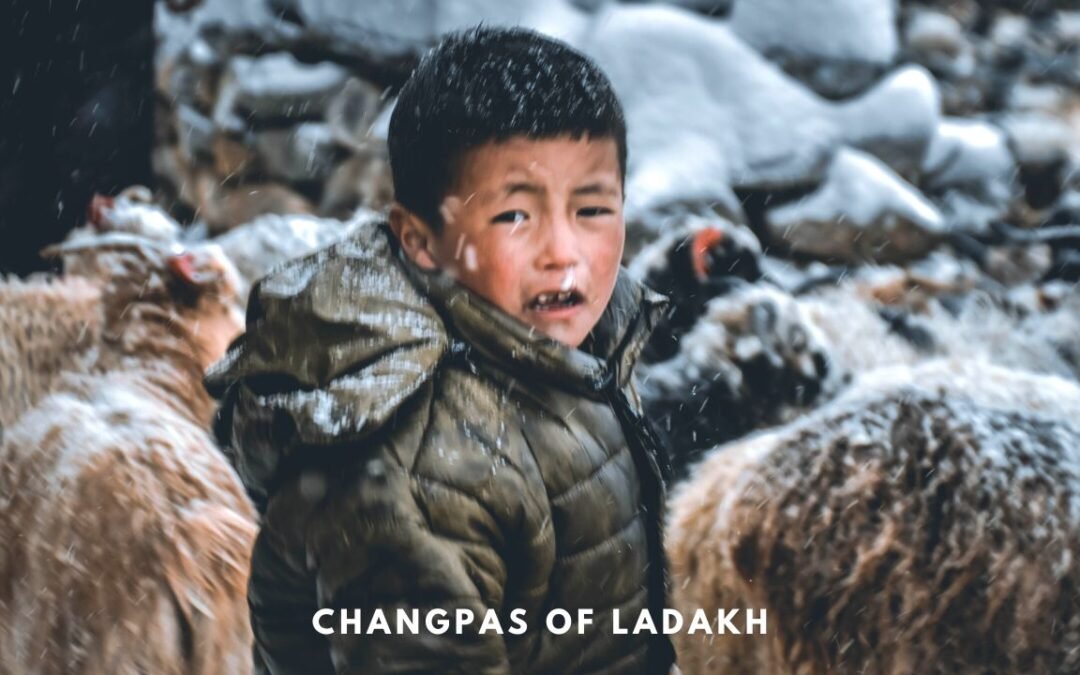


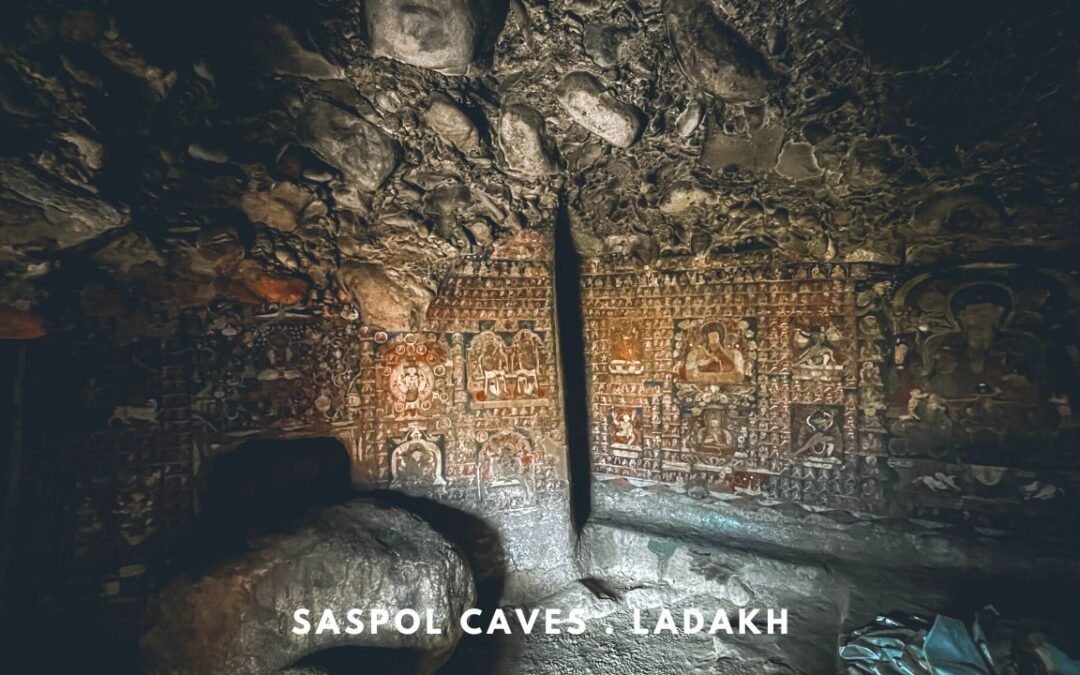
Ladakh and Leh are very much in my bucket list. The attires and headgears of Brokpas are interesting. Your travel from Kargil to the villages must have been quite adventurous considering the poor infrastructure in such places. The heritage house converted into a museum looks beautiful in your image. The ‘pregnancy tourism’ in the Aryan valley is truly interesting. I have not visited the aryan valley and would love to check it out someday. 🙂
Thank you Jan! Please visit Ladakh whenever you find it possible.
Wow! This is new to me. I’ve never heard of Aryan valley and the whole idea of it being the last place where Aryans live. I’ve heard of Alexander’s army history earlier. It is interesting how the Brokpas actually look different than the rest of Ladakhis. I’ve not heard of Bon religion either. This is very very interesting. I totally adore their head gear. The Papuya Guest house and its Heritage House are quite fascinating. Thanks for writing about this.
Thanks Bhusha! There are so many interesting things to see in the world!
Glad that you managed to make it back to the Aryan Valley. We often plan to return to places and are sad when it never happens. Interesting to read about the different theories about the history of the Brokpa tribe. And to learn more about their customs. But I found the whole idea of pregnancy tourism a bit bizarre. Even if the Brokpas are quite different from others in rest of Ladakh and might be considered by some as a superior race.
Yeah! The fact of pregnancy tourism has to be taken with a bit of salt. When I asked my host, all I got was a enigmatic smile. So yes, I am more interested in their culture, people and the landscape in general.
This place is interesting. Thank you for sharing a bit of their history. Made me appreciate it more. I think their Tepis are really beautiful. I don’t really mind wearing one.
We’d love to join the Aryan Valley Festival in the future.
Thanks Clarice!
I remember my middle school friend told us that they are Aryan. But after reading and looking at pictures in your article, I know they are Indian. It’s really interesting to learn about them, such as their origin, the way of life, believe, and more. Their tepi is definitely beautiful and interesting to learn that all the elements they put there has a meaning. It’s really an interesting culture.
Thank you!
Wonderful pictures of the Aryan Valley and the Brokpa people. Actually I have read about the Brokpa community and the beautiful hair attires in a magazine. However I thought the region is off-limits for tourists. So I am actually thrilled, that it is possible.
It was once. But now they allow tourists to visit the place, with a permit, of course.
I haven’t been to Aryan Valley, Ladakh, yet, but it’s on my dream list, as I visited Himachal Pradesh and especially love Dharamsala and its area. You had such a unique and beautiful adventure with the Brokpa community. It’s great that you could see and learn about their culture, history, and lifestyle. Your pictures are stunning. I would love to photograph Tepi. It’s great that the locals believe that the Tepi wards off the evil eye. Their religion seems to me a bit complicated, as it has so many influences; it’s so exciting, as they still follow their old custom of worshipping rivers and trees, and practice a form of animism. Staying in Payupa Guest House seems to be a great idea. I appreciate all your detailed tips on how to plan a trip to this remote region!
Thank you so much!
I am intrigued by the Aryan Valley and Brokpas people after reading your article. What’s even more mysterious is trying to figure out what is fact and what is folklore, as with the Pregnancy Tourism. I’m always a little worried when the genetic makeup of one people becomes of great interest, good or bad. But I’m happy to see these villages continue to preserve their culture and history, fairly undisturbed. And, of course, it looks like a beautiful place to visit, more so when the Apricots are in bloom!
Thank you Jackie! I am planning to visit there during the apricot blooming season!
This was such an interesting article to read. I am always interested in learning of tribes and their cultures. I think their headgear is beautiful and I love it that they still cherish their traditions. It sounds like they were friendly and don’t mind visitors. Hopefully I get to do this kind of trip myself someday.
Thank you Paula!
Excellent, we’ll narrated, please inform dates when you visited.thanks for good details and map
Thank you so much. We had visited in October.
Found out about your website today and cannot stop looking. Found you because we were looking for info about Phugtal monastery. We will try to visit in June. Make the long trip through Spiti valley from Chandigarh/Shimla to Leh, to Srinagar and back to Zanskar valley, Phugtal and Leh again. 1 full month. I found so many interesting info in your site. Will try to use as much as possible. Will attend 2 times 2 days festivals in Lamayuru and Hemis. Looking forward to it.
Thanks for your Phugtal info. We are not the youngest anymore and hope we can see it once in our life. Not the first time we visited Ladakh but not possible to get bored there.
Keep up the great work!